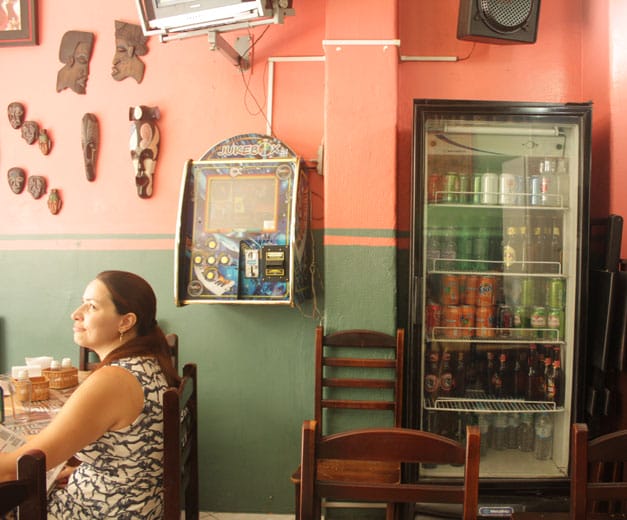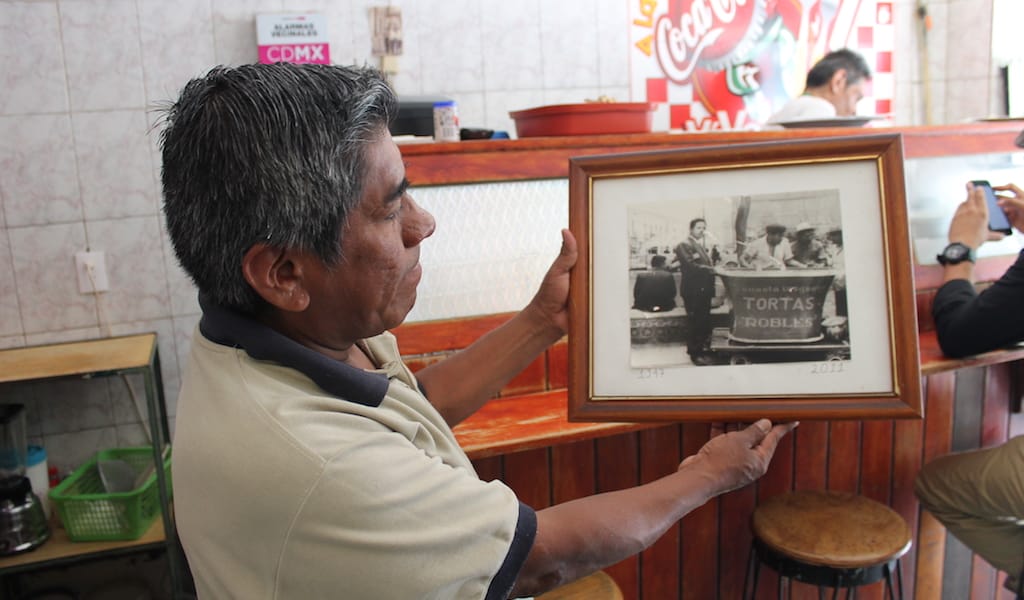Melanito Biyouha’s restaurant in São Paulo’s gritty Centro is a social sort of place. The salmon-pink dining room opens to the street, inviting passers-by to stop, bate-papo, talk football and grab a cold drink from the fridge. Others sit at tables and fill out immigration forms or apply for jobs. Everyone stays for the food, prepared in the tiny open kitchen.
Biyou’Z has been the linchpin of São Paulo’s “African Corner” since it opened in 2008. Once-grand buildings line the wide street outside. Many of them, including the one above the restaurant, are low-rent tenements, covered in meter-high pichação, the spindly form of graffiti that adorns almost every building in central São Paulo.
For more than eight years, Biyouha and her husband, Victor Macaia, have served up their fried fish, meat swimming in delicious peanut sauce and sizzling fried plantains to Brazil’s first significant, voluntary wave of African immigrants since slavery was abolished in 1888.
While many Paulistanos still avoid Centro, look past the grime and you can see evidence of a time when upper-class life in São Paulo revolved around the old center. Nearby landmarks, including the BOVESPA stock exchange and modernist skyscraper Edifício Itália, are vestiges of past waves of immigrants from Italy, Portugal and Japan, groups who arrived in Brazil at the end of the 19th and the start of the 20th centuries. (We’ve written previously about the Arab migration to the neighborhoods of Brás and Pari.)
Immigrants from across the African continent began arriving in São Paulo in the ’90s – from former Portuguese colonies Mozambique and Angola, the Ivory Coast, Nigeria, the Democratic Republic of Congo and Senegal. Their numbers are not large, but São Paulo’s newest African residents are making their presence felt in Centro. On this one block, a Nigerian-owned restaurant has opened next door to Biyou’Z, and another Nigerian-owned restaurant has set up shop two down from that. There are hair salons that specialize in treating African hair and in front of Republica train station, street vendors sell brightly colored dashikis.
Traveling for the first time in 2004 from her native Cameroon, Biyouha fell in love with Brazil and decided to stay. After a short stint in Brasília the couple moved to São Paulo and started selling clothing. They soon realized there were no restaurants in São Paulo specializing in African cuisine. They opened Biyou’Z and the rest is history.
On any given day you can hear strains of Lingal, Portuguese with a Mozambican, Angolan or Paulistano accent, Lingala, Swahili or English at the next table and as people walk past. The hearty plates of food served beneath wooden masks and a yellowing map of Africa provide a taste of home for recent arrivals.
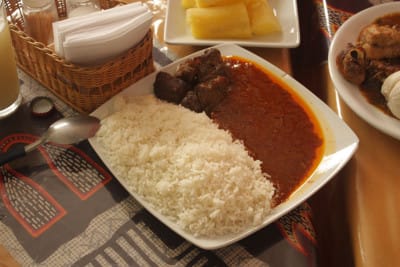 Now, an increasing number of Brazilians are discovering the distinctive flavors of Biyouha’s home-style cooking. Victor explains the menu and makes suggestions to curious Paulistanos. We tried dishes from all over the continent, including Cameroon’s national dish, ndolé, a spicy stew of bitter greens, meat and ground peanuts served with rice and fried plantains, as well as fried catfish mbongo tchobi, served with manioc (also called Brazilian arrowroot or cassava).
Now, an increasing number of Brazilians are discovering the distinctive flavors of Biyouha’s home-style cooking. Victor explains the menu and makes suggestions to curious Paulistanos. We tried dishes from all over the continent, including Cameroon’s national dish, ndolé, a spicy stew of bitter greens, meat and ground peanuts served with rice and fried plantains, as well as fried catfish mbongo tchobi, served with manioc (also called Brazilian arrowroot or cassava).
“It’s still impossible to get some of the ingredients we need,” says Biyouha, who speaks Portuguese with a Cameroonian accent. She still relies on people to bring certain spices to Brazil, including the mbongo (alligator pepper, a relative of ginger), which gives the mbongo tchobi stew its earthy flavor and distinct black color.
Also on the menu, the ubiquitous, stick-to-your-ribs fufu, a starch made from mashed manioc (or cooked yams, plantains or taro). It is served with many of the stews and soups, including Nigerian egusi, made at Biyou’Z with ground pumpkin seeds and bitter greens; mafé, made with ground peanuts; and issingul, a rich, flavorful eggplant sauce with boiled manioc and mocotó (cow’s feet).
During the week the lunch crowd is diverse. On the days we ate at Biyou’Z, hip, young families living in Centro rubbed shoulders with sharply dressed Nigerians and workers from the newspaper Folha de São Paulo, whose offices are down the street.
Biyouha estimates that 60 to 70 percent of her customers are Brazilians. “They think the food is delicious,” she says. Particular favorites are the ndolé and the fumbua, fried chicken in roasted peanut sauce, dendê (palm) oil, crushed dried shrimp and manioc.
For close to half a millennium, varied cultures of the largest African-heritage population outside Africa have shaped Brazil’s music, dance and food. The holy trinity of Bahian cuisine – dendê oil, malagueta pepper and coconut milk – were imported from Africa by Portuguese slave traders and have been incorporated into local cooking to such an extent that it would be hard to imagine Brazilian food without them. Despite this influence, you would be hard pressed to find a Paulistano who could name an African dish. Biyouha is working hard to change this, one customer at a time.
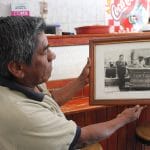 August 30, 2018 Tortas Robles
August 30, 2018 Tortas Robles
The Robles family has sold tortas in downtown Mexico City for over 70 years, earning […] Posted in Mexico City January 12, 2017 La Miniatura
January 12, 2017 La Miniatura
Julian Ramírez started out at the age of 14 as a shop boy at a busy bakery in Colonia […] Posted in Mexico City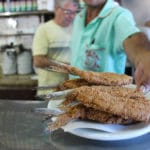 December 1, 2016 Bar Ocidental
December 1, 2016 Bar Ocidental
Downtown Rio, full of historical monuments, colonial architecture and daytime bustle, […] Posted in Rio
Brooke SwartzBrooke Swartz
Published on April 27, 2015
Related stories
August 30, 2018
Mexico CityThe Robles family has sold tortas in downtown Mexico City for over 70 years, earning generations of devoted customers. But this year could be its last. Their story begins in 1940s Mexico City, at the intersection of Doctor Mora and Juárez Avenue, the southwestern corner of the Alameda Central. Diego Rivera immortalized the famous park,…
January 12, 2017
Mexico CityJulian Ramírez started out at the age of 14 as a shop boy at a busy bakery in Colonia Guerrero in 1959, then a bustling blue-collar neighborhood, easily connected to downtown by streetcar. Back then, at La Antigua del Guerrero, he learned the business: wiping windows, sweeping up and eventually making deliveries on his bike.…
December 1, 2016
Rio | By Danielle Renwick
RioDowntown Rio, full of historical monuments, colonial architecture and daytime bustle, grows emptier during the evenings. But for the last half century, one cobblestone street has given commuters a reason to stick around: sardines. Salty, crispy, scrumptious fried sardines. Sitting at the foot of the Matriz de Santa Rita church, Beco das Sardinhas (Sardine Alley)…







































